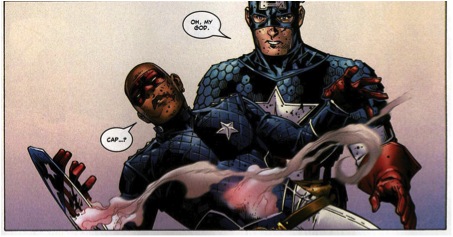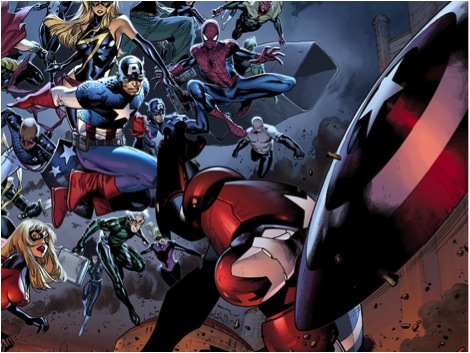In 2004, Ed Brubaker began a critically acclaimed run as writer of Captain America. There’s a reason it was critically acclaimed – it was fantastic on pretty much every imaginable front. It took the best of the spy genre, infused it with noir and sci-fi, and pretty much redefined both the title and the eponymous hero, all the while telling an accessible story that was inviting to returning readers and folks who were new to comics. I’ll get to that in another article, because I have a bit of a personal story about Brubaker’s first issue on that title. We’ll get to that.
I’m starting this article, which is very much not about Brubaker, this way because I want to make it clear that this list is by no means meant to slag off on the Bru. I’m actually in the midst of reading the last few volumes of his run – yeaaah, I’m behind – and I’ve got nothing but props to give. But I started to think. I love his take so much that, when I began assembling a list of great modern Captain America moments, I realized I was writing a retrospective of his run more than a fair and diverse list.
I began to wonder about Captain America’s influence on titles besides his own. I thought that, by disqualifying his own title from the mix, it would paint a more complex picture of a hero who is too often misconstrued, like Superman, to be a one-dimension boy scout in blue… when in reality, he’s anything but. So here are three titles in which Cap played a role, whether it be a guest spot or a more thematic presence, that stuck with me as great Captain America stories… even if they weren’t really about Captain America.
This was the first and most interesting one that came to mind. The Young Avengers title, during both its Heinberg/Cheung and Gillen/McKelvie runs, was one of my favorite books that Marvel put out. It was Cap’s role in the former that stuck with me, though. It was a nuanced portrayal, because the Young Avengers were a team of teenagers that were so inspired by the core Avengers that they modeled their heroic personas after members of the original team. However, things didn’t go so well for them when the Avengers-proper found out. Captain America, largely due to his self-hatred over the death of Bucky Barnes, was not okay with having teenagers run around as costumed heroes. And the fact that they were inspired by him and his friends to do so rubbed salt in his old wounds. He became an obstacle to the team, actively trying to shut them down. It made his role in the book complicated, as while he was the inspiration for their beginning, he was also somewhat of an antagonist, albeit a well-meaning one. The book also begged the question… is Cap right, or was Will Smith right all those years ago? Parents… (or adults playing parenting roles while wearing spandex)… just don’t understand.
Captain America played a similar role in RUNAWAYS by Brian K. Vaughan and Adrian Alphona, but the Young Avengers seemed to be a bit more on Cap’s radar than the Runaways, likely because of their choice of team names.
This is a big one. Steve Rogers was recently brought back from his kinda-but-not-really-dead death, and he once again picked up the shield and fought for truth, justice, and the not-Norman-Osborn way in this event book. The short of it is that Norman Osborn was in control of the government, and he led an unconstitutional attack on Asgard. He was taken out of power and the Avengers, led by Cap, went in to kick some ass. It was Cap’s first time back on the battlefield since his return, and his appearance in the fight bolstered the spirit – it was a fitting conclusion to the emotional role that Cap had played in many of the post-CIVIL WAR books. The New Avengers often strived to live up to his standard of integrity and heroism in their own title; the Mighty Avengers dealt with the blame of opposing him in theirs; he had elevated, in death, beyond a man and had become an idea. An ideal, even. Seeing him back as a person, fighting the good fight, brought it down to Earth again for the heroes and for me, as a reader. Captain America wasn’t an impossible ideal to strive toward – he was a guy. A guy who fought for what he believed in, who was pissed off because people had messed his country up. And while inspiring his fellow heroes, he gave Osborn hell with that shield.
The coolest part about his role in Siege, and why I chose it over the obvious Civil War, is that he ends the series by giving Bucky his shield. Because when Cap died and Bucky was back, Bucky earned that title… and Steve Rogers respected that.
An honorable mention here would definitely be Invincible Iron Man. Watching Tony deal with the guilt of his role in what led to Cap’s death, and then reacting to his resurrection and accepting his help was powerful.
This one is going to be short, because you should stop reading this article and get to the store and buy this comic. I wrote an article about JMS’s fantastic take on Thor, but my favorite issue is the one that made me ugly cry. The run took place during Cap’s death which, as mentioned before, rocked the whole of the Marvel Universe to its core. Thor pays respects to Cap in a way that shows that the man’s impact was so strong that it changed not only people, not only a country, but a god. It’s beautiful and I’ll start welling up if I keep at it, so I’m going to exit stage left!
An honorable mention here would be SECRET INVASION, where Bucky shocks a bunch of people by hitting the scene rockin’ the Cap garb. He began acting as a member of the New Avengers following this series, so it’s certainly worth checking out.
PAT SHAND is a writer and editor for Zenescope Entertainment. He spends entirely too much time on Facebook, Twitter, and Tumblr, where you can follow his writing. If you don’t like being inundate with pictures of cats, you may way to stay away.




Comments are closed.